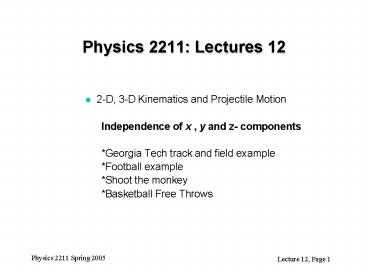Physics 2211: Lectures 12 - PowerPoint PPT Presentation
1 / 33
Title:
Physics 2211: Lectures 12
Description:
velocity of the car does not change. magnitude of the ... A car moves along a circle with constant speed. Which statement is ... Free Throws ... – PowerPoint PPT presentation
Number of Views:22
Avg rating:3.0/5.0
Title: Physics 2211: Lectures 12
1
Physics 2211 Lectures 12
- 2-D, 3-D Kinematics and Projectile Motion
- Independence of x , y and z- components
- Georgia Tech track and field example
- Football example
- Shoot the monkey
- Basketball Free Throws
2
Kinematics in Two Dimensions - Review
3
- acceleration of the car is zero
- motion of the car is one-dimensional
- velocity of the car does not change
- magnitude of the acceleration is constant
- acceleration is increasing with time
- none of the above
A car moves along a circle with constant speed.
Which statement is correct?
4
Roller Coaster
5
Position and Velocity
displacement
6
Position and Velocity
average velocity vector
7
Instantaneous velocity
8
Components of velocity
9
Instantaneous Kinematic Quantities
10
3-D Kinematics
- The position, velocity, and acceleration of a
particle in 3 dimensions can be expressed as
- We have already seen the 1-D kinematics equations
11
3-D Kinematics
- For 3-D, we simply apply the 1-D equations to
each of the component equations.
- Which can be combined into the vector equations
12
3-D Kinematics
- So for constant acceleration we can integrate to
get
- Aside the 4th kinematics equation can be
written as
13
2-D Kinematics
- Most 3-D problems can be reduced to 2-D problems
when acceleration is constant - Choose y axis to be along direction of
acceleration - Choose x axis to be along the other direction
of motion - Example Throwing a baseball (neglecting air
resistance) - Acceleration is constant (gravity)
- Choose y axis up ay -g
- Choose x axis along the ground in the direction
of the throw
14
Example
15
Example
- Treat horizontal motion and vertical motion
separately
- Then just add the results Principle of
Superposition
- Velocity at highest point
16
Example
- Vertical Motion
- Need to determine magnitude of take-off velocity
17
Example
- Magnitude of take-off velocity
18
Example
- Two footballs are thrown from the same point on a
flat field. Both are thrown at an angle of 30o
above the horizontal. Ball 2 has twice the
initial speed of ball 1. If ball 1 is caught a
distance D1 from the thrower, how far away from
the thrower D2 will the receiver of ball 2 be
when he catches it?
(1) D2 2D1 (2) D2 4D1 (3) D2 8D1
19
Example
- The horizontal distance a ball will go is simply
x (horizontal speed) x (time in air) v0x t
- To figure out time in air, consider the
equation for the height of the ball
- When the ball is caught, y y0
(time of catch)
(time of throw)
20
Example
- So the time spent in the air is
- The range, R, is thus
- Ball 2 will go 4 times as far as ball 1!
- Notice For maximum range,
21
Shooting the Monkey(tranquilizer gun)
- Where does the zookeeper aim if he wants to hit
the monkey? - ( He knows the monkey willlet go as soon as he
shoots ! )
22
Shooting the Monkey
- If there were no gravity, simply aim
at the monkey
23
Shooting the Monkey
- With gravity, still aim at the monkey!
24
Shooting the Monkey
x v0 t y -1/2 g t2
- This may be easier to think about.
- Its exactly the same idea!!
x x0 y -1/2 g t2
25
ExampleProjectile Motion Basketball Free
Throws(or life at the charity stripe)
- Projectile motion for fun and profit!
26
ExampleProjectile Motion Basketball Free
Throws
- If the basketball is thrown at 55 degrees above
the horizontal, what must its initial speed be
for the foul shot to go in?
27
Example
Constant Acceleration Problem
- Choose y axis up.
- Choose x axis parallel to the floor in the
direction of the basket. - Choose the origin (0,0) to be at the ball.
28
Example
- Find the x and y components of initial velocity
29
Example
30
Problem
- Barry Bonds clobbers a fastball toward
center-field. The ball is hit 1 m (d ) above the
plate, and its initial velocity is 36.5 m/s (v0 )
at an angle of 30o (? ) above horizontal. The
center-field wall is 113 m (D) from the plate and
is 3 m (h) high. - What time does the ball reach the fence?
- Does Barry get a home run?
31
Problem
- Choose y axis up.
- Choose x axis along the ground in the direction
of the hit. - Choose the origin (0,0) to be at the plate.
- The ball is hit at t 0, x x0 0 and y y0
d.
Kinematics equations are
32
Problem
- Use geometry to figure out v0x and v0y
33
Problem
- The time to reach the wall is t D / v0x
(easy!) - We have an equation that tells us y(t) d v0y
t - g t2/ 2 - So, were done....now we just plug in the
numbers - Find
- v0x 36.5 cos(30o) m/s 31.6 m/s
- v0y 36.5 sin(30o) m/s 18.25 m/s
- t (113 m) / (31.6 m/s) 3.58 s
- y(t) (1.0 m) (18.25 m/s)(3.58 s) - (0.5)(9.8
m/s2)(3.58 s)2 - (1.0 65.3 - 62.8) m 3.5 m
- Since the wall is 3.0 m high, Barry gets the
homer!!































